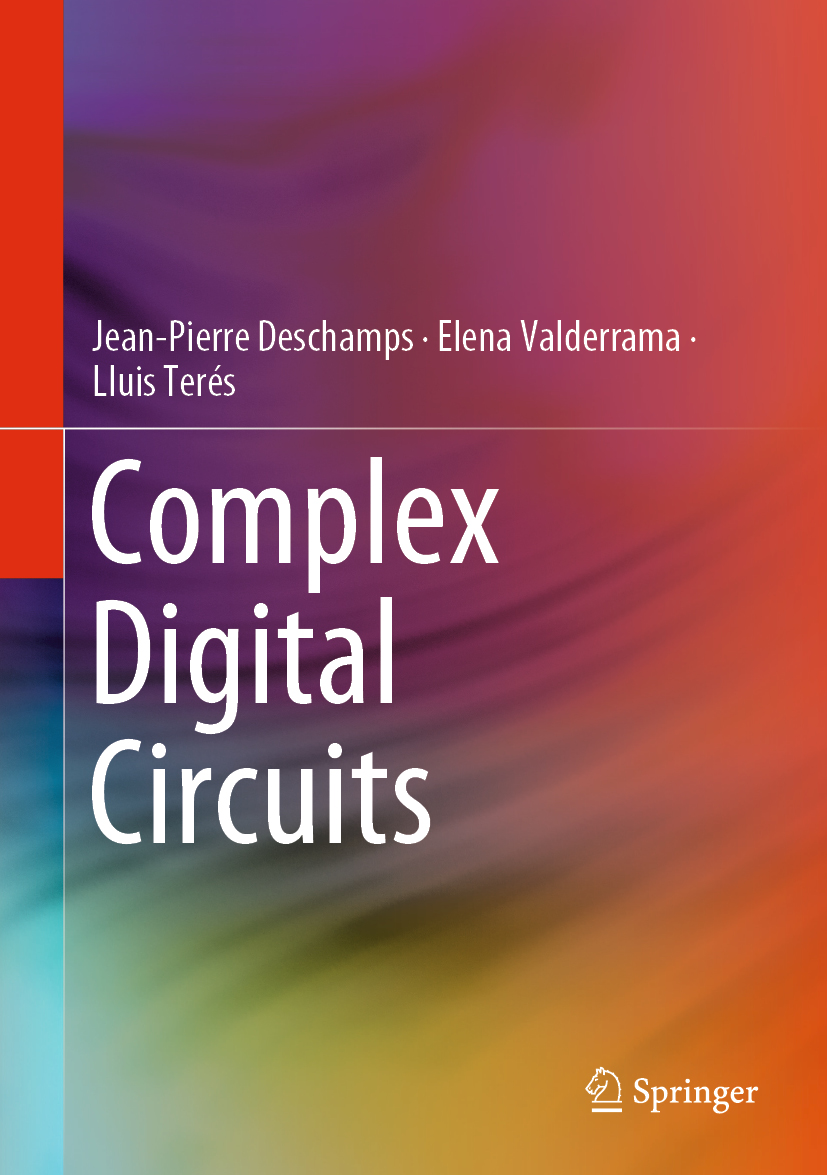VHDL Codes
Feedback
|
|
Welcome to Complex Digital Circuits
In this page you will find
VHDL codes
and other relevant information related with the book.

authors: Jean-Pierre Deschamps, Lluís
Terés, Elena Valderrama
The central topic of this book is the
description of synthesis methods that permit to transform an initial
algorithm into a specific component - a digital circuit - that satisfies
some constraints such as maximum cost, maximum size, maximum power
consumption or maximum time to market. This book is not about the
development of complete and complex digital systems, a topic that
includes both software and hardware aspects, but about the design of
digital circuits.
Nowadays, several commercial synthesis tools permit
to translate an algorithmic initial description to a digital circuit. In
fact, those tools allow synthesizing the circuit in a partially
automatic way: the designer generates the initial functional definition,
for example a C program, and guides the synthesis tool all along the
operations. So, this book addresses to several types of research and
development engineers. It describes synthesis methods and optimization
tools, so that it addresses to developers of synthesis tools. It also
addresses to developers of specific digital components, even if they use
automatic synthesis tools, helping them to understand the way those
tools are working and which are the choices to be made at each synthesis
step.
This is not an introductory text so that some previous
knowledge of digital circuit design is assumed. A basic knowledge of the
hardware description language VHDL is also recommended. This language is
used to model digital circuits and is the input language to simulation
and synthesis tools. Algorithms are defined using a pseudocode similar
to VHDL. In some cases executable VHDL processes are also used to check
the correction of the proposed algorithms. All executable programs are
available at the Authors’ web site.
Overview
Chapter 1 defines the classical
partition of a digital circuit into Data Path and Control Unit. It
starts with an introductory example. Then some general considerations
are presented.
Scheduling and resource assignment are the topics of
Chapter 2. In particular, the concept of Precedence Graph is introduced,
different related optimization problems are studied and several examples
are presented.
Chapter 3 is dedicated to pipelined circuits. The main
topics are: circuit segmentation, combinational circuit to pipelined
circuit transformation, interconnection of pipelined circuits and
self-timed circuits.
The optimal implementation of loops is a basic
aspect of the synthesis of digital circuits. It is the topic of Chapter
4. Combinational and sequential implementations are considered. This
chapter also includes the description of techniques such as
loop-unrolling and digit-serial processing.
Other topics of Data Path
synthesis are treated in Chapter 5. For example: data path connectivity
(buses), first in first out (FIFO) files, register files, arithmetic and
logic unit (ALU), hierarchical description, sequential implementation
(lower cost and longer time).
Chapter 6 is dedicated to Control
Units. Some of the studied aspects are: command encoding, hierarchical
control, variable-latency operations, sequencers and microprograms.
Several examples of input-output management protocols with the
corresponding interface circuits are described in Chapter 7.
The
last chapter is a description of currently existing development tools,
among others logic synthesis, high level synthesis (HLS), functional
simulation, logic simulation, timing analysis, intellectual property
(IP) cores, formal verification, emulators and accelerators.
Authors
Jean-Pierre Deschamps
received an MS degree in electrical engineering from the University of
Louvain, Belgium, in 1967, the PhD in computer science from the
Autonomous University of Barcelona, Spain, in 1983, and a PhD degree in
electrical engineering from the Polytechnic School of Lausanne,
Switzerland, in 1984. He worked in several companies and universities.
His research interests include ASIC and FPGA design, and digital
arithmetic. He is the author of eleven books and more than a hundred
international papers.
Elena Valderrama
received an MS degree in Physics from the Barcelona Autonomous
University (UAB), Spain, in 1975 and the PhD in 1979. Later, in 2006,
she got a degree in Medicine from the same university. She is currently
Professor at the Microelectronics department of the Engineering School
of the UAB. From 1980 to 1998 she was an assigned-researcher in the
IMB-CNM (CSIC), where she leaded several biomedical related projects in
which the design and integration of highly complex digital systems
(VLSI) was crucial. Her current interests focus primarily on Education,
not only from the point of view of the professor but also in the
management and quality control of Engineering related educational
programs. Her research interests move around the biomedical applications
of Microelectronics.
Lluís Terés Terés
received an MS degree in 1982 and the PhD in 1986, both in Computer
Sciences, from the Autonomous University of Barcelona (UAB). He is
working in UAB since 1982 and in IMB-CNM (CSIC) since its creation in
1985. He is Head of Integrated Circuits & Systems (ICAS) group at IMB
with research activity in the fields of ASIC’s, sensor signal
interfaces, body-implantable monitoring systems, integrated N/MEMS
interfaces, flexible platform-based systems & SoC, and organic/printed
microelectronics. He has participated in more than sixty industrial and
research projects. He is co-author of more than seventy papers and eight
patents. He has participated in two spin-offs. He is also a part time
Assistant Professor at UAB.
This site is under construction
apologize us for errors and mistakes

The Authors
|
The Book
|
|
Jean Pierre Deschamps
LLuis Terés
Elena
Valderrama
|
... |
Contact Info:
|
Others...
|
|
e-mail:
arithmetic.circuits@uam.es

|
|
|

